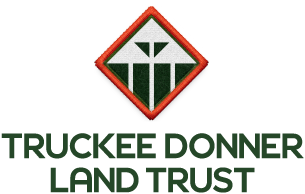Protect and Enjoy: The Science Behind Healthy Forests and Wildfire Resiliency
For the Truckee Donner Land Trust – acquiring open space, often a decade-long process, is really only the beginning. Caring for the lands we’ve protected is critical to make sure they stay healthy for generations to come, and here in the northern Sierra, forestry is a key part of that effort.
As the Land Trust Board and Staff works to protect the landscape, we’re also assessing the forest health, past conditions and what it may take to make the forest healthier and in ecological equilibrium. That’s where we often enlist the expertise of Danielle Bradfield, owner and registered professional forester of Feather River Forestry.
“When I’m working with the Land Trust I can really focus on bringing the forest back to its historic analog without having to worry about also having to produce a certain amount of board feet per acre to sell,” Danielle said. “When conservation is the priority, I can work on hastening old-growth conditions and stand health, and that’s such a wonderful thing.”
Danielle starts off by assessing the forest where she’s going to work – what’s the species composition of a stand, are there large over-story dominate trees, are there dead tops and insect damage?
Then she takes a trip back in time, digging up historic aerial photos to see what the forest used to look like.
“At Webber Lake I found a full set of aerial photos going back to 1953 – I looked at those to get a feel for stand density at the time, and then I started figuring out what kind of tree density can sustain, and what it should sustain, compared to current conditions,” Danielle said.
At Webber, she also looked at conifer encroachment on the meadows (Lacey Meadow and Coppins Meadow) over time. Conifer encroachment occurs when fire is removed from the landscape or watercourses are altered. The altered landscape allows conifers, usually lodgepole pines, to colonize former meadows, replacing grasses and willows with dense forest.
Then, Danielle said, she starts considering the factors she wants to improve in a forestry project like wildfire resiliency, ecology and habitat, how stand density is affecting the water table, rare and sensitive species, and so on.
On Land Trust lands, the goal in weighing all these factors is to create a resilient forest – but what does that mean?
“Resiliency varies from site to site, but in general, if we have a damaging agent enter the forest like insects, disease or wildfire – a resilient forest should be able to continue functioning as an ecosystem,” Danielle said. “A few trees may die, but on a landscape-scale, things are still working. That’s resiliency.”
On the other end of the spectrum, Danielle is seeing damage from some of the recent and ongoing wildfires on forests that don’t have that resiliency due to past mismanagement and fire suppression – which was standard practice in the Sierra for decades.
“That’s problematic – we can be better stewards than this so they can withstand an occasional lightning strike.” Danielle said.
At Webber, Danielle focused on thinning small understory trees and stopping pines from encroaching on the meadow where they affect the water table, whereas at Royal Gorge, she focused on a shaded fuel break designed to slow advancing fire (a side effect of this project was sun reaching the forest floor and a bonanza of wildflowers).
The science and practice of forestry has evolved in Danielle’s time – but the changes she’s most excited about are in line with the Land Trust’s mission: moving from forestry designed for timber harvest (extractive use) to forestry designed to create a healthy forest. Likewise some of the on-the-ground techniques are evolving to be lower impact while taking trees – reducing impacts to the land while working.
“Even when I was in forestry school things were very production-oriented,” Danielle said. “Now it’s not so much about looking at what an acre can produce, but how do we get it back to historic balance and better adapted to climate change. It’s nice to see that cultural shift.”
But Danielle is quick to point out that these changes don’t make her, or the industry, anti-logging or against the use of wood products.
“Timber production and ecosystem services aren’t mutually exclusive anymore, and wood can still be a good renewable resource that sequesters carbon at the same time,” she said.
Recently Danielle oversaw two forestry projects totaling nearly 400 acres at Webber Lake and at Royal Gorge funded with more than $750,000 from a Sierra Nevada Conservancy grant. The Land Trust and Danielle have a variety of other forestry projects on Land Trust lands in the works and appreciate the support of donors like you to help preserve these beautiful places.
This is part of a series of stories titled “Protect and Enjoy,” if you want to learn more about an aspect of natural science, behind-the-scenes of what the Land Trust does, or the history of our lands, please send an email to greyson@tdlandtrust.org with your idea.
Looking at Lacey Meadow left of Webber Lake, conifer encroachment on the meadow is visible.


